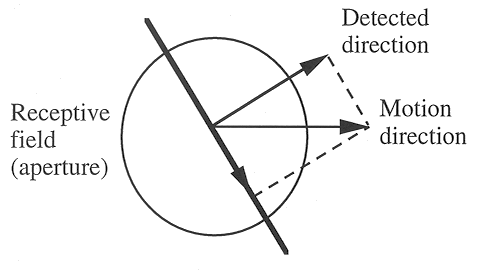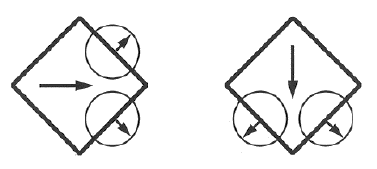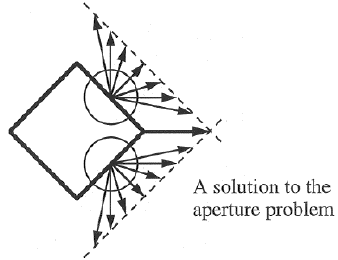
The aperture problem is encountered when detecting a global motion, such as the motion of an object which occupies quite a fraction of the entire visual field. As discussed earlier, each motion sensor, such as a V1 cell, can only detect a 1D motion, the velocity component perpendicular to the local line feature inside its receptive field. The true motion of the 2D object, also called the pattern motion, cannot be detected directly from its many local motions. This ambiguity can be overcome in several different ways.

As the result of this aperture problem, the motion of a visual object composed of many components of different orientations, called pattern or global motion cannot be detected, as shown here

A simple method called intersection of constraints (IOC) is proposed by [62] for solving the aperture problem. This method uses only the local motions of two edge pieces to compute the global motion by finding the intersection of all possible global motions consistent with the two local motions detected. The global motion velocity of the object can be easily computed using IOC from the two edges of the 2D object associated with the top vertex of the object, as shown here:

Mathematically, the aperture problem can be solved the same way as an ill-posed problem by imposing additional constraining conditions such as the smoothness constraint discussed in previous section. Other additional conditions used include the assumptions of pure translational motion, rigid 3D object motion, and quadric 3D surface motion (see [19] for review).
However, the various mathematical methods proposed to solve the aperture problem are unlikely to be used by the biological visual system for detecting global motion. For example, the IOC method is very simple mathematically but not feasible biologically, and the same is true for the other methods. What we need is a biologically plausible integration process which computes the 2D global motion of a pattern from the many 1D motions detected locally. In the following, We will first consider the biological properties of the neurons in both V1 and MT areas, and then propose a possible way for some of the MT cells (called pattern cells) to detect global motion.